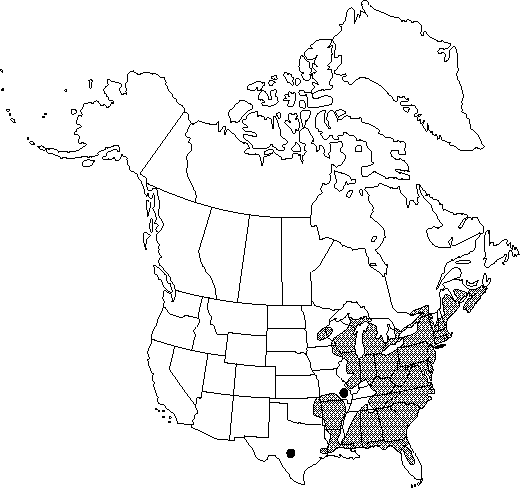Difference between revisions of "Hamamelis virginiana"
Sp. Pl. 1: 124. 1753.
FNA>Volume Importer |
FNA>Volume Importer |
||
| Line 66: | Line 66: | ||
}}<!-- | }}<!-- | ||
| − | --><span class="statement" id="st- | + | --><span class="statement" id="st-undefined" data-properties=""><b>Shrubs </b>or small trees, to 6(-10.6) m, suckering, forming dense clumps, not aromatic and resinous. <b>Leaves</b> not persistent in winter; petioles 6-15(-20) mm. <b>Leaf</b> blade broad-elliptic to nearly rounded or obovate, 3.7-16.7 × 2.5-13 cm, base strongly oblique and rounded, sometimes somewhat cuneate and weakly oblique, apex acute to short-acuminate or broadly rounded; surfaces abaxially pale green, not glaucous. <b>Flowers</b> appearing in autumn, faintly fragrant; calyx adaxially yellow-green to yellow; petals pale to deep yellow, rarely reddish, 10-20 mm; staminodes conspicuously dilated. <b>Capsules</b> 10-14 mm. <b>Seeds</b> 5-9 mm. <b>2n</b> = 24.</span><!-- |
-->{{Treatment/Body | -->{{Treatment/Body | ||
| Line 101: | Line 101: | ||
|publication year=1753 | |publication year=1753 | ||
|special status=Selected by author to be illustrated | |special status=Selected by author to be illustrated | ||
| − | |source xml=https://jpend@bitbucket.org/aafc-mbb/fna- | + | |source xml=https://jpend@bitbucket.org/aafc-mbb/fna-data-curation.git/src/9216fc802291cd3df363fd52122300479582ede7/coarse_grained_fna_xml/V3/V3_410.xml |
|genus=Hamamelis | |genus=Hamamelis | ||
|species=Hamamelis virginiana | |species=Hamamelis virginiana | ||
| − | |||
| − | |||
| − | |||
| − | |||
| − | |||
| − | |||
| − | |||
| − | |||
| − | |||
| − | |||
| − | |||
| − | |||
| − | |||
| − | |||
| − | |||
| − | |||
| − | |||
| − | |||
| − | |||
| − | |||
| − | |||
| − | |||
| − | |||
| − | |||
| − | |||
| − | |||
| − | |||
| − | |||
| − | |||
| − | |||
| − | |||
}}<!-- | }}<!-- | ||
-->[[Category:Treatment]][[Category:Hamamelis]] | -->[[Category:Treatment]][[Category:Hamamelis]] | ||
Revision as of 14:40, 27 July 2019
Shrubs or small trees, to 6(-10.6) m, suckering, forming dense clumps, not aromatic and resinous. Leaves not persistent in winter; petioles 6-15(-20) mm. Leaf blade broad-elliptic to nearly rounded or obovate, 3.7-16.7 × 2.5-13 cm, base strongly oblique and rounded, sometimes somewhat cuneate and weakly oblique, apex acute to short-acuminate or broadly rounded; surfaces abaxially pale green, not glaucous. Flowers appearing in autumn, faintly fragrant; calyx adaxially yellow-green to yellow; petals pale to deep yellow, rarely reddish, 10-20 mm; staminodes conspicuously dilated. Capsules 10-14 mm. Seeds 5-9 mm. 2n = 24.
Phenology: Flowering fall (Oct–Nov [Dec]).
Habitat: Dry woodland slopes, moist woods, bluffs, and high hammocks
Elevation: 0-1500 m
Distribution

N.B., N.S., Ont., Que., Ala., Ark., Conn., Del., D.C., Fla., Ga., Ill., Ind., Iowa, Ky., La., Maine, Md., Mass., Mich., Minn., Miss., Mo., N.H., N.J., N.Y., N.C., Ohio, Okla., Pa., R.I., S.C., Tenn., Tex., Vt., Va., W.Va., Wis.
Discussion
Hamamelis virginiana exhibits a complex range of variation, not easily reconciled taxonomically, especially in the leaves and flowers. In the northern part of the range, the leaves are larger, averaging 9 × 2.6 cm, the petals are bright yellow, and the plants are normally shrubby. In South Carolina, Georgia, and Florida, the leaves are usually smaller, averaging 6.2 × 4.1 cm, the petals are distinctly pale yellow, and the plants sometimes attain small tree proportions, to 30 cm in trunk diameter. Such plants have been referred to as H. virginiana var. macrophylla. On the Ozark Plateau, H. virginiana and H. vernalis are sympatric. There the petals of H. virginiana are often reddish at the base, indicating the role of hybridization in that part of the range. Infraspecific taxa are not recognized for H. virginiana because no consistently defined pattern of variation or geographic correlation can be identified with this plant.
Hamamelis virginiana was well known as a medicinal plant by Native Americans. Cherokee, Chippewa, Iroquois, Menominee, Mohegan, and Potowatomi tribes used it as a cold remedy, dermatological aid, febrifuge, gynecological aid, eye medicine, kidney aid, and in other ways (D. E. Moerman 1986).
Witch-hazel was subsequently used by the early European settlers in similar ways. A tea of the leaves was employed for a variety of medicinal purposes. The twigs were used as divining rods (water-witching), thus giving the vernacular name to the plant. Modern uses employ both the bark and leaves, and a good demand still exists for the pleasant-smelling water of witch-hazel, derived from the leaves and bark. The products are used in skin cosmetics, shaving lotions, mouth washes, eye lotion, ointments, and soaps.
Hamamelis virginiana is sometimes cultivated, largely for its autumn flowering.
The largest known tree of Hamamelis virginiana, 10.6 m in height with a trunk diameter of 0.4 m, is recorded from Bedford, Virginia (American Forestry Association 1994).
Selected References
None.
